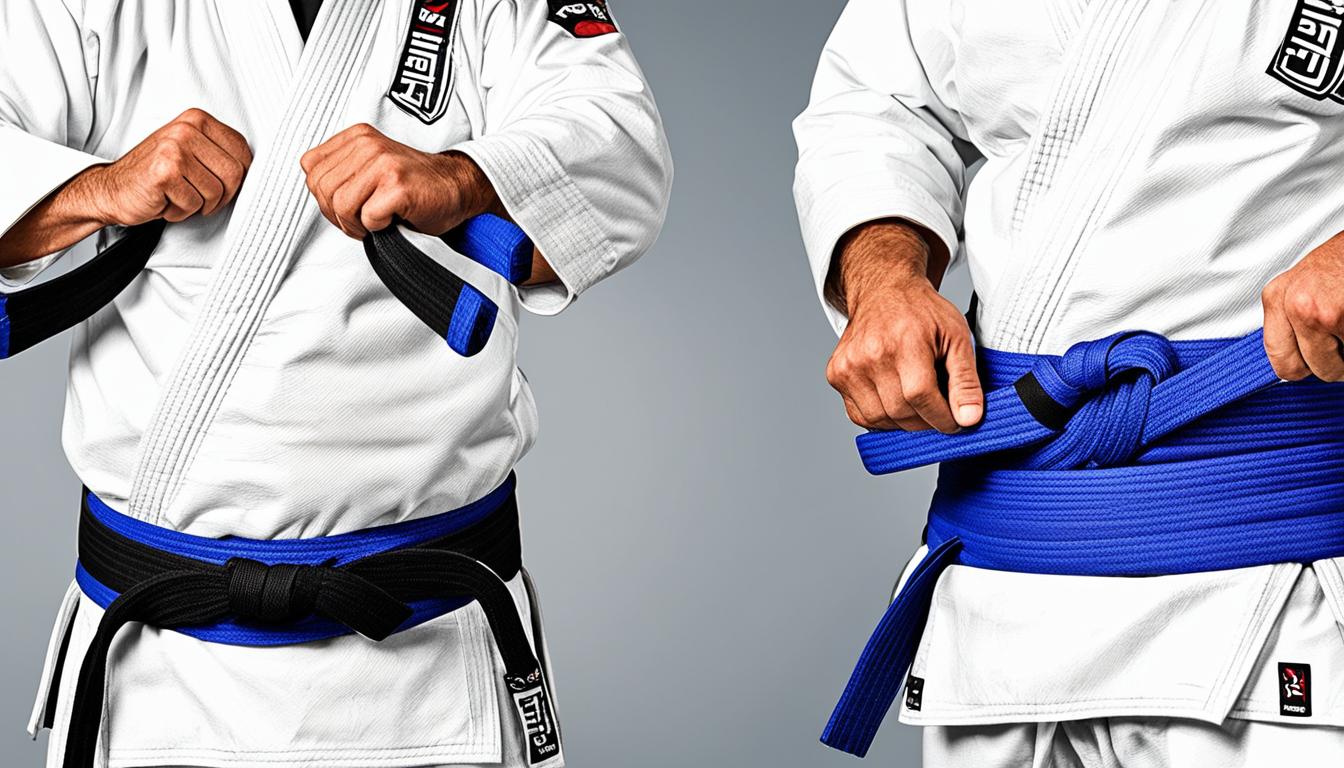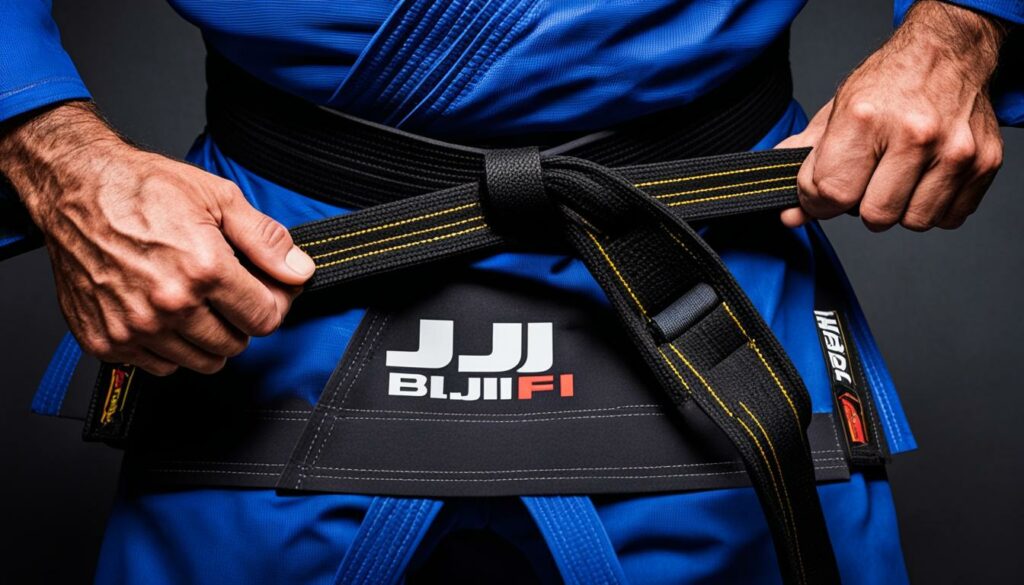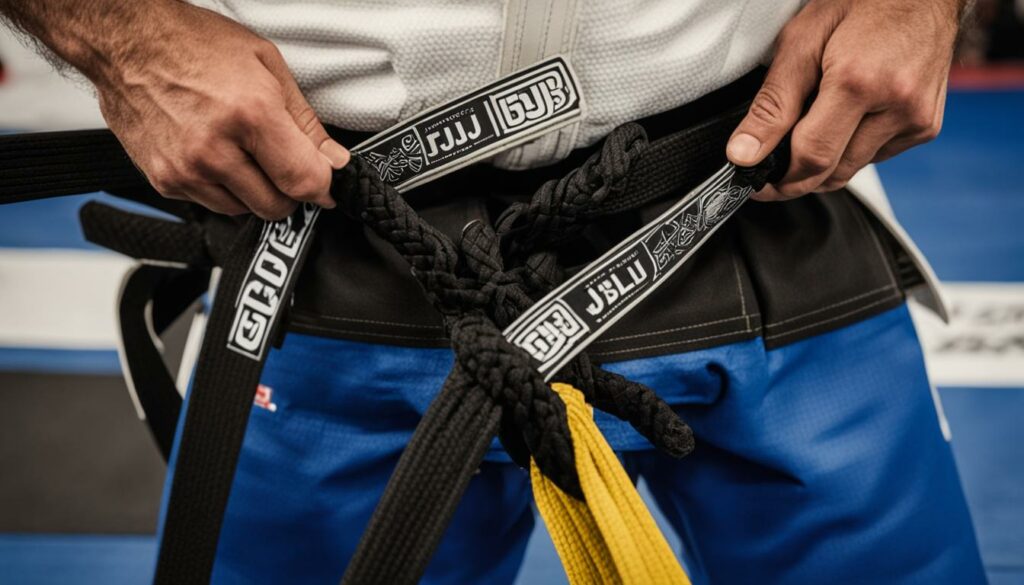As a devoted Brazilian Jiu-Jitsu enthusiast, I understand the pivotal role of a well-tied belt in the martial arts world. It’s not just about keeping your Gi jacket in place during an intense roll; it’s a sign of respect for the discipline and an art within itself. I’m excited to share a step-by-step guide on tying a BJJ belt that simplifies this essential practice. Whether you’re a complete beginner or a seasoned practitioner looking to refine your skills, these instructions will help you achieve that perfect knot every time.
Throughout this guide, I’ll walk you through the “Usual Way” of tying your belt, which is straightforward yet effective, and the “Deluxe Way”, providing a more secure and aesthetically pleasing finish. Either way, you’ll be leaving the mat with a knot that honors the BJJ traditions and your personal dedication. Let’s get into the details and master the art of tying a BJJ belt together.
Key Takeaways
- Understanding the symbolism and practicality of a properly tied BJJ belt
- Learning two main methods: the “Usual Way” and the “Deluxe Way”
- Gaining a step-by-step understanding of securing your BJJ belt
- Emphasizing the importance of tying techniques in BJJ’s revered traditions
- Ensuring your Gi stays in place with a securely tied belt for the duration of your training
The Importance of Mastering Brazilian Jiu-Jitsu Belt Tying Techniques
As a martial artist, I understand that wearing the Brazilian Jiu-Jitsu (BJJ) belt is more than a mere formality. It is a practice steeped in tradition, representing my rank and progresses in this dynamic sport. That’s why mastering the Brazilian Jiu-Jitsu belt tying techniques holds a unique significance in the martial arts community; it’s not just about tying a piece of cloth around my waist, but expressing respect for the art itself.
Symbolism and Practicality of a Well-Tied Belt
The proper way to tie a BJJ belt reflects both the beauty of tradition and the necessity for functionality. When tied correctly, it symbolizes my commitment and hard-earned progress. White, blue, purple, brown, and black—each color signifies a step on a long journey in BJJ where every stripe and color holds a meaning of its own. But symbolism aside, there’s a clear practical reason to ensure my belt is secured well—it must hold my Gi jacket in place as I grapple, ensuring no disruption in my flow of movement during rigorous training sessions.
The Role of Belt Tying in BJJ’s Belt Ranking System
The ranking system in BJJ distinguishes itself through belt colors, and each practitioner strives to uphold their rank’s integrity through a well-tied knot. A proper way to tie a BJJ belt supports the Gi’s functionality, crucial during every roll on the mats or in competition. It’s the small nuances like this that set the tone for excellence, discipline, and detail-oriented practice in BJJ. Both beginners and seasoned veterans appreciate the role that a securely tied belt plays—it’s a commitment to the art, a display of proficiency, and an unspoken pledge to always bring their best to the mat.
Step-by-Step Guide on How to Tie a BJJ Belt
Whether I’m preparing for a BJJ class or gearing up for competition, I’ve found that one of the fundamental skills I need to master is quick and easy bjj belt tying. A well-tied belt not only looks professional but also prevents any unwanted interruptions during training. Let me walk you through the bjj belt tying instructions I adhere to for that perfect knot.
- Find the center of the belt and place it on your stomach, just above the waistline of your pants.
- Wrap the belt around your back, crossing the ends over each other to generate a snug fit.
- Bring the ends back to the front, ensuring they are even.
- Place the right end over the left and bring it underneath both layers of the belt, pulling it up tight to your body.
- Now take the left end (which should be on the top) and fold it down.
- Then take the right end, which is now at the bottom, and bring it up across the center of the folded left end.
- Create a loop with the top layer where these two ends intersect.
- Thread the bottom end through this loop from below.
- While holding the loop, pull both ends to tighten the knot securely, making sure that the ends are even and hang neatly to the sides.
- Adjust the tension to prevent any slippage but avoid making it too tight, allowing for full range of motion.
World Champion BJJ black belt Leandro Issa recommends these steps as being crucial to a knot that not only holds its integrity during a session but also shows respect towards your art and training. The method may take a few practices to get right, but it’s worth the effort for both form and function. Now, let’s take a look at an image that helps illustrate these tying steps:
Remember, the initial times I tied my belt using this procedure, it did feel intricate. However, like any technique in BJJ, repetition is the key to making this a smooth and efficient process. A well-tied belt boosts confidence and posture, epitomizing the readiness to train or compete. As I practice, I recall these steps not just as a ritual but as a reinforcement of my commitment to BJJ.
Additional Tips for Securing a Tight Knot on Your BJJ Belt
As someone passionate about Brazilian Jiu-Jitsu (BJJ), I understand the importance of a securely tied belt. It’s not simply about keeping your Gi in place, but it’s also a reflection of your dedication to the art. To ensure your belt stays tied and your focus remains on the match, follow these tips for achieving a tight knot on your bjj belt.
Choosing the Right Belt Length for Optimal Fit
Finding the right belt length is crucial as it affects how well the knot will hold. A belt that’s too short will often come undone, whereas a belt that’s too long can get in the way. A common rule of thumb is that when your belt is tied, the ends should hang down to the middle of your thigh. This allows enough length to wrap around twice and still have the necessary fabric to pull tight and secure.
- Belt should wrap around your waist twice with about 20-30 cm of length remaining on each end after the knot.
- When purchasing a new belt, consider shrinking factor if it’s made of cotton. Buy slightly longer to accommodate.
- Aim for symmetry in the ends post-knot for not just aesthetics but also to ensure an even and secure fit.
Maintaining Your Belt: Cleanliness Without Compromising Integrity
Maintaining the integrity of your BJJ belt is not only about how you tie it but also how you care for it. A clean belt is essential for hygiene in the dojo. Despite old myths, washing your belt won’t wash away your knowledge — but it will keep away potentially harmful bacteria.
- Wash your belt after each training session to maintain hygiene.
- Use a gentle detergent to preserve the belt’s material and colors.
- Avoid bleach and high heat drying to prevent fraying and fading.
Remember, tying your BJJ belt with a proper knot and keeping it clean are acts of respect — to yourself, your art, and your training partners. Implement these tips into your routine and the integrity of your belt and practice will never come undone.
Common Mistakes When Tying a BJJ Belt and How to Avoid Them
As I delve into the world of Brazilian Jiu-Jitsu, I’ve learned that tying a BJJ belt is an art in itself. It’s a task that requires attention to detail to avoid the common pitfalls practitioners often encounter. Below, I’ll share the frequent errors made and provide insights on how to sidestep them, ensuring your belt is tied efficiently and reliably.
One of the easiest mistakes to make when tying a BJJ belt is reversing the order of steps. This often leads to a knot that’s prone to come undone or, even worse, could be uncomfortable during training. Another issue is not maintaining equal lengths of the belt on both sides when starting the tying process, which can result in an uneven wrap and an unbalanced appearance.
- Starting with uneven ends, leading to an asymmetric knot
- Tying the belt too loosely, causing it to unravel easily during sparring
- Over-tightening the knot, which can restrict movement and cause discomfort
- Ignoring belt maintenance, leading to wear and tear that could affect the tie
| Mistake | Consequence | How to Avoid |
|---|---|---|
| Incorrect Step Sequence | Awkward and Unstable Knot | Follow the traditional step-by-step method |
| Uneven Belt Lengths | Unbalanced and Untidy Appearance | Double-check for symmetry before tying the knot |
| Excessively Loose Knot | Belt comes undone easily | Pull each step tight while tying for a secure hold |
| Over-tightening | Restricts movement and causes discomfort | Tighten just enough for the belt to stay in place |
Remember, tying your BJJ belt flawlessly is not only about looking good on the mat but also about demonstrating respect for the discipline. By practicing the correct technique and avoiding these common mistakes, you’ll ensure that your belt is a symbol of both expertise and tradition in Brazilian Jiu-Jitsu.
Conclusion
Through the journey of Brazilian Jiu-Jitsu, mastering the intricate details such as achieving a secure knot for a BJJ belt is more than just a routine—it is a rite that carries the essence of our discipline and the respect we hold for this martial art. The method I choose, whether it’s the swift and manageable technique or the deluxe version for a touch of sophistication, both serve the purpose of attaining a firm knot that represents my commitment to the craft. This knot, as simple as it might seem, is the emblem of countless hours of perseverance on the mat.
Perfecting this facet of BJJ is not merely about functionality—it’s also a tribute to the vibrant culture and long-standing traditions of Brazilian Jiu-Jitsu that we uphold. It’s not just about making sure my Gi jacket stays in place, it’s about maintaining a seamless expression of the respect inherent in this art. So, I always take the time to practice and refine my belt-tying skills to ensure my appearance mirrors the quality of my technique in every training session.
As I continue to progress in BJJ, each knot tied is a reminder of my growth and the journey ahead. The belt, therefore, is not just part of my uniform, but a part of my narrative in BJJ. A confidently tied belt, brings a sense of readiness to engage in the physical and mental challenges of Brazilian Jiu-Jitsu, which is why I commit to tying it right, every single time.



